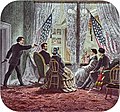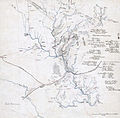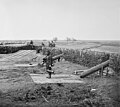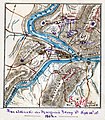Portal:American Civil War
 |
 |
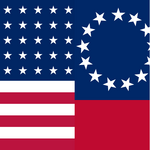
The American Civil War (1861–1865) was a sectional rebellion against the United States of America by the Confederate States, formed of eleven southern states' governments which moved to secede from the Union after the 1860 election of Abraham Lincoln as President of the United States. The Union's victory was eventually achieved by leveraging advantages in population, manufacturing and logistics and through a strategic naval blockade denying the Confederacy access to the world's markets.
In many ways, the conflict's central issues – the enslavement of African Americans, the role of constitutional federal government, and the rights of states – are still not completely resolved. Not surprisingly, the Confederate army's surrender at Appomattox on April 9,1865 did little to change many Americans' attitudes toward the potential powers of central government. The passage of the Thirteenth, Fourteenth and Fifteenth amendments to the Constitution in the years immediately following the war did not change the racial prejudice prevalent among Americans of the day; and the process of Reconstruction did not heal the deeply personal wounds inflicted by four brutal years of war and more than 970,000 casualties – 3 percent of the population, including approximately 560,000 deaths. As a result, controversies affected by the war's unresolved social, political, economic and racial tensions continue to shape contemporary American thought. The causes of the war, the reasons for the outcome, and even the name of the war itself are subjects of much discussion even today. (Full article)
The Battle of Marion (December 17–18, 1864) was a military engagement fought between units of the Union Army and the Confederate Army during the American Civil War near the town of Marion, Virginia. The battle was part of Union Maj. Gen. George Stoneman's attack upon southwest Virginia, aimed at destroying Confederate industrial infrastructure near Saltville and Marion. Union Cavalry and Infantry regiments—some 4,500 soldiers in total—left Tennessee on December 17 for southwestern Virginia.
Through two days of fighting, a Confederate force under the command of John C. Breckinridge—totalling 1,200–1,500 infantry and cavalry—was successful in holding defensive positions in and around the town of Marion. On the first day, successive Union attacks were defeated by a well-coordinated Confederate defenses near a covered bridge outside of Marion. By the end of the second day, dwindling ammunition supplies forced Confederate forces to withdraw from the area. With casualties for both sides approaching 300, Union forces proceeded to destroy the salt mines, lead works, and other beneficial Confederate infrastructure in Marion and Saltville. (Full article...)

Louisiana was a dominant population center in the southwest of the Confederate States of America, controlling the wealthy trade center of New Orleans, and contributing the French Creole and Cajun populations to the demographic composition of a predominantly Anglo-American country. In the antebellum period, Louisiana was a slave state, where enslaved African Americans had comprised the majority of the population during the eighteenth-century French and Spanish dominations. By the time the United States acquired the territory (1803) and Louisiana became a state (1812), the institution of slavery was entrenched. By 1860, 47% of the state's population were enslaved, though the state also had one of the largest free black populations in the United States. Much of the white population, particularly in the cities, supported slavery, while pockets of support for the U.S. and its government existed in the more rural areas.
Louisiana declared that it had seceded from the Union on January 26, 1861. Civil-War era New Orleans, the largest city in the South, was strategically important as a port city due to its southernmost location on the Mississippi River and its access to the Gulf of Mexico. The U.S. War Department early on planned for its capture. The city was taken by U.S. Army forces on April 25, 1862. Because a large part of the population had Union sympathies (or compatible commercial interests), the U.S. government took the unusual step of designating the areas of Louisiana then under U.S. control as a state within the Union, with its own elected representatives to the U.S. Congress. For the latter part of the war, both the U.S. and the Confederacy recognized their own distinct Louisiana governors. Similarly, New Orleans and 13 named parishes of the state were exempted from the Emancipation Proclamation, which applied exclusively to states in rebellion against the Union. (Full article...)
Ulysses S. Grant (born Hiram Ulysses Grant; April 27, 1822 – July 23, 1885) was an American military officer and politician who served as the 18th president of the United States from 1869 to 1877. As commanding general, Grant led the Union Army to victory in the American Civil War in 1865 and briefly served as U.S. secretary of war. An effective civil rights executive, Grant signed a bill to create the Justice Department and worked with Radical Republicans to protect African Americans during Reconstruction.
Grant was born in Ohio and graduated from West Point in 1843. He served with distinction in the Mexican–American War, but resigned from the army in 1854 and returned to civilian life impoverished. In 1861, shortly after the Civil War began, Grant joined the Union Army and rose to prominence after securing Union victories in the western theater. In 1863, he led the Vicksburg campaign that gave Union forces control of the Mississippi River and dealt a major strategic blow to the Confederacy. President Abraham Lincoln promoted Grant to lieutenant general after his victory at Chattanooga. For thirteen months, Grant fought Robert E. Lee during the high-casualty Overland Campaign which ended with capture of Lee's army at Appomattox, where he formally surrendered to Grant. In 1866, President Andrew Johnson promoted Grant to General of the Army. Later, Grant broke with Johnson over Reconstruction policies. A war hero, drawn in by his sense of duty, Grant was unanimously nominated by the Republican Party and then elected president in 1868. (Full article...)
- ... that Romeo and Juliet both served in the Union Navy?
- ... that the Confederate States Navy ordered six Squib-class torpedo boats from England, but they were never delivered?
- ... that singer Frank Croxton performed a duet with his father for the unveiling of a monument to a Confederate States Army general?
- ... that Francis Orray Ticknor was a country doctor whose fame as a poet relies on "Little Giffen", a poem about one of his patients who died in the American Civil War?
- ... that some Confederate bullets were sourced from a silver mine?
- ... that Colonel Bradley Winslow was brevetted by US president Abraham Lincoln for "brave and gallant conduct" during the siege of Petersburg in the American Civil War?
- Attention needed
- ...to referencing and citation • ...to coverage and accuracy • ...to structure • ...to grammar • ...to supporting materials
- Popular pages
- Full list
- Cleanup needed
- The West Tennessee Raids
- Requested articles
- James Ashby (soldier) • Bluffton expedition • Benjamin D. Fearing • Charles A. Hickman • Richard Henry Jackson • James B. Speers • Charles S. Steedman • Battle of Barton's Station • Lawrence P. Graham • Thomas John Lucas • Daniel Henry Rucker • James Hughes Stokes • Frederick S. Sturmbaugh • Davis Tillson • Action at Nineveh (currently a redirect) • International response to the American Civil War • Spain and the American Civil War • Savannah Campaign Confederate order of battle • Native Americans in the American Civil War (currently disambiguation after deletion) • 1st Battalion, Mississippi Mounted Rifles (Union) • Battle of Lafayette • Requested American Civil War Medal of Honor recipients
- Expansion needed
- Battle of Boonsborough • Battle of Guard Hill • Battle of Rice's Station • Battle of Simmon's Bluff • Battle of Summit Point • Charleston Arsenal • Edenton Bell Battery • First Battle of Dalton • Blackshear Prison • Edwin Forbes • Hiram B. Granbury • Henry Thomas Harrison • Louis Hébert (colonel) • Benjamin G. Humphreys • Maynard Carbine • Hezekiah G. Spruill • Smith carbine • Edward C. Walthall • Confederate States Secretary of the Navy • Confederate States Secretary of the Treasury • David Henry Williams • Battle of Rome Cross Roads • Delaware in the American Civil War • Ironclad Board • United States Military Railroad • Kansas in the American Civil War • Rufus Daggett • Ebenezer Magoffin • Confederate Quartermaster-General's Department • First Corps, Army of Northern Virginia • Francis Laurens Vinton • Henry Maury • Smith's Expedition to Tupelo • Other American Civil War battle stubs • Other American Civil War stubs
- Images needed
- Battle of Lone Jack • Preston Pond, Jr. • Melancthon Smith
- Merging needed
- 1st Regiment New York Mounted Rifles and 7th Regiment New York Volunteer Cavalry
- Citations needed
- 1st Alabama Cavalry Regiment (Union) • 4th Maine Battery • 33rd Ohio Infantry • 110th New York Volunteer Infantry • Battle of Hatcher's Run • Camp Dennison • Confederate colonies • CSS Resolute • Dakota War of 1862 • Florida in the American Civil War • Ethan A. Hitchcock (general) • Fort Harker (Alabama) • Gettysburg (1993 film) • Iowa in the American Civil War • Second Battle of Fort Sumter • Samuel Benton
- Translation needed
- Add an article here!
The following Wikimedia Foundation sister projects provide more on this subject:
-
Commons
Free media repository -
Wikibooks
Free textbooks and manuals -
Wikidata
Free knowledge base -
Wikinews
Free-content news -
Wikiquote
Collection of quotations -
Wikisource
Free-content library -
Wikiversity
Free learning tools -
Wikivoyage
Free travel guide -
Wiktionary
Dictionary and thesaurus
- Shortcuts to this page: Portal:ACW • P:ACW






